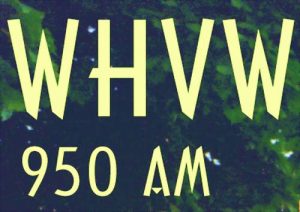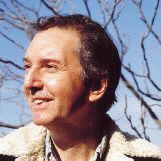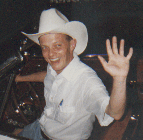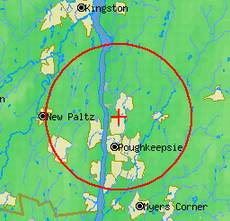The following article originally appeared on The Radio Kitchen blog by Michael Pool, a.k.a. “The Professor.” In an effort to preserve his writings and recordings, we are republishing The Professor’s archived posts in a special collection here on the SWLing Post.
Note that not all of the original links and recordings could be recovered, but the majority have been. Of course, all of the views and opinions in this article were those of The Professor.
“The Hip Spot On Your Dial” was originally published on December 10, 2007. Enjoy:
The Hip Spot On Your Dial
by The Professor
I’m old enough to remember when they first pulled the oldies radio concept out of the box and plugged it into the wall. And it literally was a gadget. A machine. I was a kid in suburban Detroit in the early 1970’s when I found one of very first all “oldies” stations to go on the air. The station (which started on FM, then simulcast on AM and eventually became an AM station), and then became known as “Honey Radio.” There were no DJ’s, just jingles, commercials and lots of dated top 40.
Automatic or not, the programming of Honey Radio was immediately intriguing to me and some of my friends at the time. As the album rock format was wandering deeper into crap like Uriah Heep and Kansas, I’d impatiently fumble with the dial looking for something (anything) different and kept perching the needle on this new station that played only old rock and roll. Half of it I’d never heard before.
It’s hard to imagine now, when most oldies stations play such a tight and boring playlist, but the original oldies format was born in the “American Graffiti” (and then “Happy Days”) era, when old rock and roll was immediately more evocative and uplifting than the arena rock epic thud and guitar solos that were clogging up the album rock format.
From what I recall of early Honey Radio format, the music spanned from 1955 until 1967 or ‘68. I started soaking it up– Rockabilly, r&b, doo-wop, even dopey pop. I loved it all (okay, except Neil Sedaka…). And it filled in a missing chapter in top 40 history for me– between my mom’s record collection and the music I had been hearing on the radio since diapers. Listening to the station turned me on to a whole world of recording artists I barely knew before (and ones you probably won’t hear much on oldies radio nowadays), like Huey “Piano” Smith, Ral Donner or the Impressions. And not just the big canonical hits, but other choice tracks that charted too. All that from a robot radio station.
 A little later (after I’d stopped obsessively listening), Honey Radio added real DJ’s and in the final tally had a good run as Detroit’s premiere oldies station until shutting down in the early 90’s. The demise of Honey came as the format’s followers were surging into middle-age, and the new thinking in advertising advocated virtually abandoning that once valued demographic. This shift in advertising strategy drove more and more oldies outlets to desperately expand their playlists into the hits of the1980’s, and drop almost all the 50’s and early 60’s music that fueled the original format.
A little later (after I’d stopped obsessively listening), Honey Radio added real DJ’s and in the final tally had a good run as Detroit’s premiere oldies station until shutting down in the early 90’s. The demise of Honey came as the format’s followers were surging into middle-age, and the new thinking in advertising advocated virtually abandoning that once valued demographic. This shift in advertising strategy drove more and more oldies outlets to desperately expand their playlists into the hits of the1980’s, and drop almost all the 50’s and early 60’s music that fueled the original format.
 There are some good, even interesting, oldies stations that are still out there (WLNG, for example). And a few brave ones have popped up and bucked the era-shift gentrification of the oldies format, and specialized in the early rock era with music libraries much larger than the mind-numbing 300 tested superhits that make up the format in most markets. However, these days radio stations exist in a cutthroat environment, where anything but sucking in big piles of money every day isn’t just unacceptable. It’s fatal. The profit margin possible with creatively (or lovingly) programmed oldies radio is almost never enough to keep these stations alive for very long. It’s not that true-blue oldies stations don’t attract a loyal audience, it just isn’t big enough or young enough to have a chance in the dog-eat-dog world of contemporary radio advertising. That is, unless you happened to have purchased a radio station for a really reasonable price, and making a fat profit isn’t necessarily your goal. Then you have choices. Then you have WHVW.
There are some good, even interesting, oldies stations that are still out there (WLNG, for example). And a few brave ones have popped up and bucked the era-shift gentrification of the oldies format, and specialized in the early rock era with music libraries much larger than the mind-numbing 300 tested superhits that make up the format in most markets. However, these days radio stations exist in a cutthroat environment, where anything but sucking in big piles of money every day isn’t just unacceptable. It’s fatal. The profit margin possible with creatively (or lovingly) programmed oldies radio is almost never enough to keep these stations alive for very long. It’s not that true-blue oldies stations don’t attract a loyal audience, it just isn’t big enough or young enough to have a chance in the dog-eat-dog world of contemporary radio advertising. That is, unless you happened to have purchased a radio station for a really reasonable price, and making a fat profit isn’t necessarily your goal. Then you have choices. Then you have WHVW.
A true media miracle, WHVW in Hyde Park/Poughkeepsie, New York, is the ultimate oldies station for the culturally inspired fan of American roots music. While there’s a number of hosted regular programs, the majority of the WHVW’s air time is occupied by a music automation system, otherwise known as “Murray the Machine.”
 Programmer/owner “Pirate Joe” Ferraro has radically expanded the oldies format with Murray. But instead of following the present-day model of stretching the format forward in time and taking on dodgy material, Joe has lopped off the late 60’s music and everything that followed. No psychedelia, no bubble gum, and thankfully no Jim Croce. While he’s held on to the doo-wop and rockabilly of the classic 1955 to 1964 era (adding a helping of folk music that was popular at the time), the rest of library goes further back in time. But unlike the hit parade highway you might hear on senior citizen radio, Ferraro opts for the rural routes of r&b, blues, old jazz, and classic country. All and all, it’s the rockin’ 20th century– an “oldies” overview based on favorites of record collectors and the kind of music that kept people putting nickels in jukeboxes for decades. While I haven’t done a scientific study of all the ingredients of Pirate Joe’s automated format, but I can tell you one thing– it’s compelling, and unlike any radio station I’ve ever heard. And it makes a lot of sense.
Programmer/owner “Pirate Joe” Ferraro has radically expanded the oldies format with Murray. But instead of following the present-day model of stretching the format forward in time and taking on dodgy material, Joe has lopped off the late 60’s music and everything that followed. No psychedelia, no bubble gum, and thankfully no Jim Croce. While he’s held on to the doo-wop and rockabilly of the classic 1955 to 1964 era (adding a helping of folk music that was popular at the time), the rest of library goes further back in time. But unlike the hit parade highway you might hear on senior citizen radio, Ferraro opts for the rural routes of r&b, blues, old jazz, and classic country. All and all, it’s the rockin’ 20th century– an “oldies” overview based on favorites of record collectors and the kind of music that kept people putting nickels in jukeboxes for decades. While I haven’t done a scientific study of all the ingredients of Pirate Joe’s automated format, but I can tell you one thing– it’s compelling, and unlike any radio station I’ve ever heard. And it makes a lot of sense.
For the last decade or so, I’ve had family in Poughkeepsie, which places me within the transmission range of WHVW a few times a year. I’ve stacked up a number of airchecks of WHVW over the years– mostly captures of Murray on the job. But what a well nursed and well-fed automation system Ferraro has set up. No matter how many tapes I’ve gathered of his automation over the years, it always sounds fresh.
WHVW – Murray the Machine 11-23-07 61:35
(download)
 While the Pirate Joe’s music machine does a heck of a job, there’s a skeleton crew of real live on-air personalities who keep WHVW human as well, and fun to listen to. Like Pirate Joe (who does a wonderful afternoon drive weekday shift himself), the DJ’s musical appetites are mostly variations on Joe’s musical themes– record collector/characters who live and breathe old jukebox shakin’ hits and rarities. Curt Roberts, the morning drive guy goes for more of an eclectic golden oldies approach, adding some soul and garage sounds to the mix. And what a voice. And the personalities of Roberts and Ferraro set the tone for the on-air persona of WHVW– wry and dry and isn’t the music great. It’s straight-forward– rarely exuberant and rarely boring. And I like it.
While the Pirate Joe’s music machine does a heck of a job, there’s a skeleton crew of real live on-air personalities who keep WHVW human as well, and fun to listen to. Like Pirate Joe (who does a wonderful afternoon drive weekday shift himself), the DJ’s musical appetites are mostly variations on Joe’s musical themes– record collector/characters who live and breathe old jukebox shakin’ hits and rarities. Curt Roberts, the morning drive guy goes for more of an eclectic golden oldies approach, adding some soul and garage sounds to the mix. And what a voice. And the personalities of Roberts and Ferraro set the tone for the on-air persona of WHVW– wry and dry and isn’t the music great. It’s straight-forward– rarely exuberant and rarely boring. And I like it.
WHVW – Curt Roberts 11-22-07 29:55
[This audio has not been recovered.]
I don’t get up in WHVW territory enough to know the schedule well, and their website (which looks like it was put together with mid-90’s know-how) usually seems a bit out of date. But you can see what the official schedule was late last year here (the link to this page has mysteriously fallen off the home page). And while it’s not much a web site, there is some history of the station and a few pictures. And sadly, they do not stream their air signal there (or anywhere). But if you want to get an idea of some of WHVW’s glowing fan mail, Joe has posted a bit of it on this page.
One show that’s been a Sunday mainstay for well over a decade now is Darwin Lee Hill’s “Real Hillbilly Jamboree.” It’s a three hour hand-crafted hootenanny, featuring hits & obscurities from all the classic country music sub-genres, as well as some more recent material from neo-traditionalists and aging legends. That said and all technical descriptions aside, Darwin’s show is consistently warm and informative radio, including occasional interviews with country legends. And the music is always heartening. Kinda makes you wanna buy a second home in Poughkeepsie.
WHVW – Darwin Lee 11-25-07 62:08
(download)
 I wish I could say that WHVW could be the harbinger of a new creative era of AM music programming. But I’m a realist, and there’s little reason to think that the glory of this little radio station is much more than fortunate happenstance. As his nickname implies, Ferraro is a former radio pirate, someone with synergistic mastery of musicology and old radio technology, who happened to get a good deal ($350,000) on a lowly class D AM station. While there’s still bargains like that around, they’re more likely in desolate North Dakota or rural Mississippi. WHVW is located in an actual city (albeit a small one), surrounded by the fringe suburbia of New York City. It’s a convergence that brings a big chunk of musical Americana to the radio dial in a place where people really live and play, or at least drive through on their way to Albany.
I wish I could say that WHVW could be the harbinger of a new creative era of AM music programming. But I’m a realist, and there’s little reason to think that the glory of this little radio station is much more than fortunate happenstance. As his nickname implies, Ferraro is a former radio pirate, someone with synergistic mastery of musicology and old radio technology, who happened to get a good deal ($350,000) on a lowly class D AM station. While there’s still bargains like that around, they’re more likely in desolate North Dakota or rural Mississippi. WHVW is located in an actual city (albeit a small one), surrounded by the fringe suburbia of New York City. It’s a convergence that brings a big chunk of musical Americana to the radio dial in a place where people really live and play, or at least drive through on their way to Albany.
And the station doesn’t operate in a vacuum, WHVW really serves the community. They have locally oriented talk shows and local news, something you don’t hear very often these days on stations with far larger budgets and bigger transmitters. And requests from listeners carry a lot more weight when the DJ actually programs their own show. For folks who live in the mid-Hudson Valley who love great (and occasionally obscure) old music, WHVW must be a godsend.
 For those who might have dreams of snatching up a cheap radio station and running it on a shoestring, Ferraro’s WHVW offers an intriguing model. Two people on staff (including the owner) handling the weekly drive-time slots and then a roster of weekly volunteer hosts doing shows for the love of it (and perhaps the advertising they can generate), with the rest of the broadcast day filled with the offerings of a tasteful and compelling automated music mix. This way a small radio station can maintain a local connection and eschew the predictable dependency on pre-packaged music formats and syndicated talk shows. And I think that WHVW disproves the bias of a number of non-conformist radio types I’ve known who equate radio automation with a lack of imagination or laziness. It all depends on who’s programming the machine.
For those who might have dreams of snatching up a cheap radio station and running it on a shoestring, Ferraro’s WHVW offers an intriguing model. Two people on staff (including the owner) handling the weekly drive-time slots and then a roster of weekly volunteer hosts doing shows for the love of it (and perhaps the advertising they can generate), with the rest of the broadcast day filled with the offerings of a tasteful and compelling automated music mix. This way a small radio station can maintain a local connection and eschew the predictable dependency on pre-packaged music formats and syndicated talk shows. And I think that WHVW disproves the bias of a number of non-conformist radio types I’ve known who equate radio automation with a lack of imagination or laziness. It all depends on who’s programming the machine.
Now in the age of mp3 players, I suppose you could spend a couple of years loading up on thousands of old shakin’ and stompin’ classics and kinds create your own WHVW in your pocket. But it would still be an imitation of Pirate Joe’s musical vision. Which is on the air right now by the way. Filling the sky of Dutchess Country with radio waves carrying the likes of Coleman Hawkins, T-Bone Walker or Harry “The Hipster” Gibson, proving that automated radio can be a non-conformist’s best friend. And that it’s not impossible for a radio station to be a better music machine than a money machine.


I first discovered WHVW on the trip to Upstate NY on the NY Thruway. I loved what I was hearing. They do now stream via Tune In. A very similar but unrelated station is WGPA Sunny 1100 out of Bethlehem PA. They also stream via Tune In.